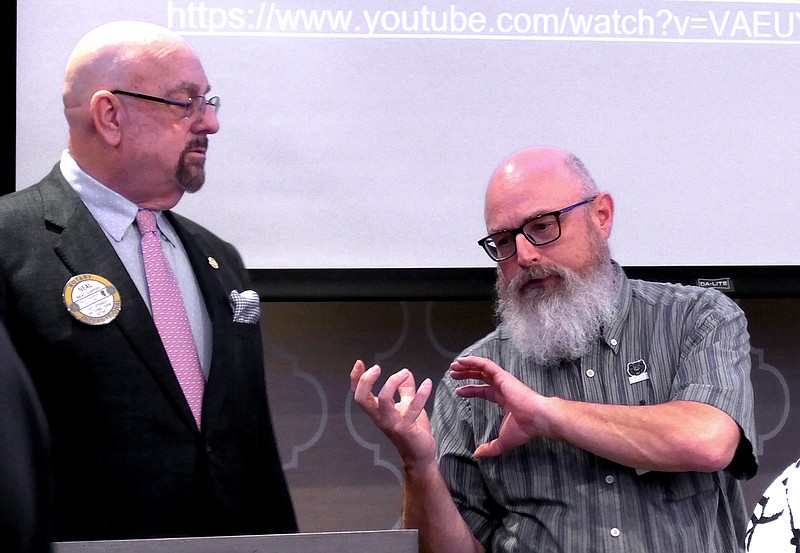Hot Springs is in the proximity to experience a total solar eclipse on April 8, 2024, which Scott Austin, an associate professor of physics and astronomy at the University of Central Arkansas, said could attract visitors from around the country and the world.
Austin visited Hot Springs on Wednesday, speaking to members of the Hot Springs National Park Rotary Club about the impending solar eclipse.
"You guys are familiar with hosting horse races," he said. "This is gonna be, if it's clear on April 8 of next year, it's gonna be kinda like you're hosting the Kentucky Derby. You're gonna have a lot of people.
"I don't know how far out the hotels take reservations. I'm gonna say I'm anticipating if they're taking booking, you're booked up already for that weekend. This is gonna be happening on a Monday, so you're gonna have people rolling in Friday," Austin said. "Especially if the weather forecast looks good."
Compared with the 2017 eclipse, Austin said, the 2024 eclipse from parts of Arkansas will be much more impressive. A total eclipse, in which the moon will block out the sun in the path of totality, which includes Hot Springs, is a rare occurrence, he said.
"The last time Arkansas had a legitimate total solar eclipse was over 100 years ago, 1918," he said. "And from what I've been able to gather it was kinda cloudy that day, so it wasn't totally ideal.
"That's why there are people called eclipse chasers. ... There are people who do, they see one of these, it's a life-changing experience, they want to see every one they can," Austin said.
Certain criteria are needed for a solar eclipse to take place, he said. Those criteria include the moon being in its new phase and the moon being in the correct place in its orbit.
"The moon's orbit is tilted about 5 degrees relative to our orbit around the sun," Austin said. "Now if that tilt wasn't there, we would have lunar and solar eclipses every month. Every time you had a full moon, you'd have a lunar eclipse. Every time you had a new moon, you'd have a solar eclipse. But because of that tilt, it doesn't always happen every month.
"Most of the time, that shadow either goes above the earth or below the earth, and we don't get any visible eclipses. So that's the other thing," he said. "It has to be in the right phase and the moon needs to be in the same plane as us and the sun.
"Just those two things alone mean that these are relatively rare events. The other thing is if you want a total solar eclipse, you need the moon to be able to totally cover the sun, and it can't always do that. The orbit of the moon isn't a perfect circle," Austin said.
The moon's place in its orbit affects how wide the moon appears in the sky, same as the sun, he said.
"Bottom line is, you might have the moon pass in front of the sun, but if the sun is too big and the moon is too small, it ain't gonna happen, OK?" Austin said. "It'll pass in front of the sun, but you won't get totality. You'll get something called an annular eclipse."
In 2017, the eclipse covered about 90% of the sun from Arkansas, he said, but the difference between 90% and 100% is much more when discussing solar eclipses.
"People are hooting and hollering because it looks like a black hole in the sky," he said of the line of totality of the 2017 eclipse, which didn't include Arkansas. "Literally, a black hole in the sky. You can see the outer atmosphere of the sun.
"But people went nuts. People didn't go nuts here in 2017 in Arkansas. We were (about) 90%, but there's a big difference between 90 and 100," he said.
The closer to the center of the totality path a person is, the longer they will be able to see the solar eclipse, Austin said, noting that from Hot Springs, the 2024 eclipse will last for about 3 ½ minutes.
In any other eclipse, it is not safe to look at the sun with no eye protection, but during a total solar eclipse, only while the moon is totally blocking the sun, it is safe to look at the eclipse with no protection, he said.
"If you can see the sun at all, the disc of the sun at all, you don't wanna be looking at it with just your eyes," Austin said.
"You can go online, you can find pictures from optometrists where people have a permanent record on their retina of a partial solar eclipse, where you can see the crescent," he said. "So it's no joke in terms of permanent eye damage."
When looking for protective eyewear, Austin suggested being careful where to shop.
